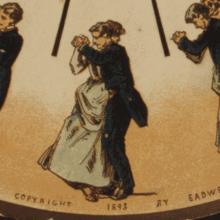 A phenakistoscope animation by Eadweard Muybridge demonstrating the waltz | |
| Genre | Ballroom dance |
|---|---|
| Time signature | 3 4 |

The waltz (from German Walzer [ˈvalt͡sɐ̯]), meaning "to roll or revolve")[1] is a ballroom and folk dance, in triple (3
4 time), performed primarily in closed position. Along with the ländler and allemande, the waltz was sometimes referred to by the generic term German Dance in publications during the late 18th and early 19th centuries.[2]
- ^ Etymology Online
- ^ Cliff Eisen (2001). "German Dance (Ger. Deutsche, Deutscher Tanz, Teutsche; Fr. allemande; It. tedesco)". Grove Music Online. Oxford University Press. doi:10.1093/gmo/9781561592630.article.10937.